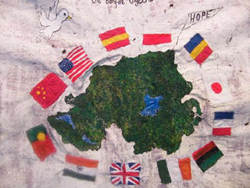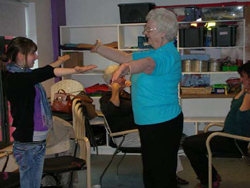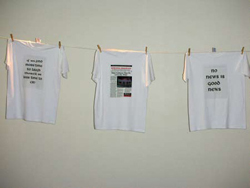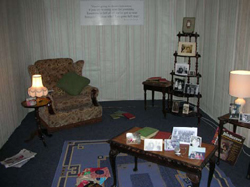Putting Their Arms around Memories
An alumna turns oral histories of Ireland's troubles into art in a Macy exhibit
In 2004, TC alumna Jill Strauss had a life-changing experience when the boat she was traveling on docked in Northern Ireland Belfast
“I saw great work happening there,” she says.
Inspired, Strauss, who received her Ed.M. in International Trancultural Studies, with a concentration in Peace Education, subsequently relocated to Northern Ireland for two years, enrolling in the University of Ulster
With the intention of exploring “whether the arts can create alternative paths for individuals and communities in conflict to better understand each other,” Strauss embarked on a five-month ethnographic case study, bringing together an intergenerational group of Protestants and Catholics. The older generation, who were between the ages of 60 and 70, had the opportunity to tell stories about their experiences and the younger generation, who were between the ages of 20 and 23, interpreted the narratives and memories, using visual arts as a medium.
That artwork was exhibited at Macy Gallery from February 8- 19, in What MORE is going on in this picture?: An Inter-Generational, Cross-Community (Catholic and Protestant) Storytelling and Visual Arts Project from Northern Ireland
Pieces on display included “Banner of Hope” by Gillian Davidson, which depicts the Northern Ireland
For another piece, Nuala Gallagher listened to tales from Norma McConville, who worked as a Protestant housing officer, about entering into the homes of Catholics and always being offered a cup of tea, despite the obvious feelings of being “different” or “other.” Gallagher broke delicate china cups and saucers and then pieced them back together, representing the resiliency of the human spirit.
For the artists and storytellers, the outcome of Strauss’s project reaches beyond the accomplishment of art-making. Members of the older generation experienced validation of their stories, Strauss says, especially when they were able to see representations of them hanging on a gallery wall. The younger generation, for their part, became more active listeners. Strauss says that Davidson told her she now listens to her friends more intently, spending more time looking at them instead of at her watch. “They asked her what was wrong with her,” Strauss recalls, smiling.
This summer, the show will be exhibited again at a gallery at John Jay College of Criminal Justice, where Strauss teaches. The Irish studies program at Queens College
Referencing the title of one of the installations in the show, Strauss says, “You can’t put your arms around a memory."
Published Monday, May. 10, 2010



